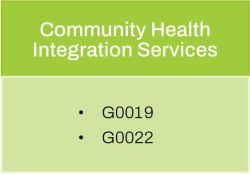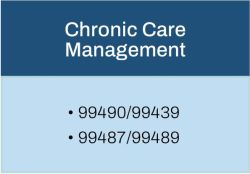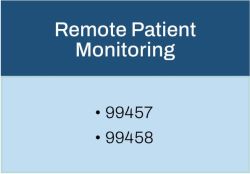2024 Medical Final Rule
Key Highlights
2024 Medicare Final Rule Documentation
“Taken holistically, these are some of the largest changes ever towards a Medicare that recognizes people with Medicare as whole persons, with their own families and unique life stories. After all, people are more than the sum of their ailments and diagnoses.”
– Meena Seshamani, MD, CMS Deputy Administrator and Director of the Center for Medicare
“As previously discussed, there is increasing recognition within the health care system of the need to take SDOH into account when providing health care services, given that it is estimated that around 50 percent of an individual’s health is directly related to SDOH…”
– CMS Final Rule 2024
At A Glance
| Section | Starting Page | Ending Page |
|---|---|---|
Community Health Integration (CHI) | 307 | 343 |
Social Determinants of Health Assessment | 343 | 361 |
Principal Illness Navigation (PIN) | 361 | 402 |
CHI and PIN for FQHC & RHCs | 765 | 782 |
General Supervision Care Management Services






Community Health Integration Services
Person-centered assessment, performed to better understand the individualized context of the intersection between the SDOH need(s) and the problem(s) addressed in the initiating visit.
- Understand patient’s life story, strengths, needs, goals, preferences and desired outcomes, including understanding cultural and linguistic factors and including unmet SDOH needs.
- Facilitating patient-driven goal-setting and establishing an action plan.
- Providing tailored support to the patient as needed to accomplish the practitioner’s treatment plan.
Practitioner, Home, and Community-Based Care Coordination
- Coordinating receipt of needed services from practitioners, service providers, social service providers, and caregiver.
- Communication with practitioners regarding the patient’s psychosocial strengths and needs. Facilitating access to community-based social services to address the SDOH need(s).
- Coordination of care transitions between and among health care practitioners, including referral to other clinicians; follow-up after an ER visit; discharges from hospitals, etc.
Helping the patient contextualize health education provided by the patient’s treatment team with the patient’s individual needs, goals, and preferences, in the context of the SDOH need(s),and educating the patient on how to best participate in medical decision-making.
Building patient self-advocacy skills, so that the patient can interact with members of the health care team and related community-based services addressing the SDOH need(s), in ways that are more likely to promote personalized and effective diagnosis or treatment.
Health care access / health system navigation. Helping the patient access healthcare, including identifying appropriate practitioners or providers for clinical care and helping secure appointments with them.
Facilitating behavioral change as necessary for meeting diagnosis and treatment goals, including promoting patient motivation to participate in care and reach person-centered diagnosis or treatment goals.
Facilitating and providing social and emotional support to help the patient cope with the problem(s) addressed in the initiating visit, the SDOH need(s), and adjust daily routines to better meet diagnosis and treatment goals.
Leveraging lived experience when applicable to provide support, mentorship, or inspiration to meet treatment goals.
- The focus of CHI services is on addressing the particular SDOH need(s) that are interfering with, or presenting a barrier to, diagnosis or treatment of the patient’s problem(s) addressed in the CHI initiating visit. SDOH(s) may include but are not limited to:
- food insecurity
- transportation insecurity
- housing insecurity
- unreliable access to public utilities
- Consent must be obtained once unless there is a change in the billing provider. Patients must be notified that cost sharing will apply and that only one practitioner per month can bill the services.
- The Initiating Visit can be TCM, AWV, E&M and cannot be an E&M furnished in an ED, SNF, inpatient, or observation visit. The patient cannot participate if they are under home health.
- Auxiliary personnel can identify new SDOH needs however – Mcare will not allow auxiliary personnel to make the determination that the SDOF needs are impacting the diagnosis or treatment of a problem. New SDOH needs must be documented so the provider has the ability to assess whether those needs can be met through CHI services.
- Third parties can perform the service as long as they are under the clinical care and treatment by the billing provider
- Can separately bill for other care management services during the same month as CHI services, if time and effort are not counted more than once, requirements to bill the other care management service are met, and the services are medically reasonable and necessary.

Principal Illness Navigation Services
-
SDOH needs are not required for use PIN services but may be applicable
-
PIN services can be furnished in addition to other care management services as long as time and effort are not counted more than once, requirements to bill the other care management services are met, and the services are medically reasonable and necessary.
-
The Initiating Visit can be TCM, AWV, E&M but cannot be an E&M furnished in an ED, SNF, inpatient, or observation visit.
-
These consent requirements include informing the patient about applicable cost sharing, the right to discontinue services, and, where applicable, the limitation that payment is made for the service to only one practitioner per month.
-
PIN services can be provided more than once per practitioner per month for any single serious high-risk condition. CMS does not expect a patient to require multiple PIN services for a prolonged period of time, except in circumstances in which a patient is receiving PIN services for highly specialized navigation, such as behavioral health or cancer.
-
Documentation of the PIN services is required to track a patient’s progress, describe the interventions and PIN service elements performed, and to describe the medical necessity of PIN services. Documentation is also required to describe the ongoing need or changes to the treatment plan that allow for the cessation of PIN services
-
Auxiliary personnel performing PIN services do not necessarily have to document the services in the medical record themselves. Rather, the billing practitioner is responsible for ensuring appropriate documentation of the PIN services provided to the patient is included in the medical record
Care Management Services Comparison
| CHRONIC CARE MANAGEMENT (CCM) | PRINCIPAL CARE MANAGEMENT (PCM) | COMMUNITY HEALTH INTEGRATION (CHI) | PRINCIPAL ILLNESS NAVIGATION (PIN) | |
|---|---|---|---|---|
|
Patient Eligibility Criteria
|
2+ chronic conditions expected to last at least 12 months
|
1 chronic condition expected to last at least 3 months
|
SDOH need(s) that are interfering with, or presenting a barrier to, diagnosis or treatment of the patient’s problem(s)
|
1 chronic condition expected to last at least 3 months or meets the clinical definition of a “serious illness”. Can be billed for each condition if time is met.
|
|
Base Code Reimbursement
|
$60.57
|
$59.26
|
$60.57
|
$60.57
|
|
Base Code Time Required
|
20 min
|
30 min
|
60 min
|
60 min
|
|
Add-on Code Reimbursement
|
$45.84
|
$45.84
|
$45.84
|
$45.84
|
|
Add-on Code Time Required
|
20 min
|
30 min
|
30 min
|
30 min
|
|
Add-on Frequency Limitation
|
2x
|
2x
|
None
|
None
|
|
Performed by
|
Clinical Staff
|
Clinical Staff
|
Auxiliary Staff
|
Auxiliary Staff
|
|
Initiating Visit
|
Once
|
Once
|
Once
|
Once
|
|
Consent Required
|
Yes
|
Yes
|
Yes
|
Yes – Annually
|
|
Subject to cost-sharing
|
Yes
|
Yes
|
Yes
|
Yes
|
|
Other Requirements
|
EMR documentation, care plan, 24/7 Access
|
EMR documentation, care plan, 24/7 Access
|
EMR documentation (Z codes “encouraged”)
|
EMR documentation (Z codes “encouraged”)
|
Auxiliary Personnel
General Rules
-
Under § 410.26(a)(1) of our regulations, auxiliary personnel must meet any applicable requirements to provide the services performed incident to the billing practitioner’s professional services, including licensure, that are imposed by the State in which the services are being furnished.
-
Many States have applicable rules and certifications, and there are existing certification programs for navigators working in certain settings of care or with specified conditions, such as cancer navigators, diabetes navigators, cardiovascular navigators, mental health navigators, geriatric care navigators, pediatric navigators, social worker navigators, primary care navigators, general patient advocate navigators, and nurse navigators in ambulatory settings.
-
We are not finalizing a required number of hours of training for auxiliary personnel to provide PIN services.
Requirements
In States where there are no applicable licensure or other laws or regulations relating to individuals performing CHI or PIN services, we require auxiliary personnel to be trained on:
-
The competencies of patient and family communication
-
Interpersonal and relationship-building skills
-
Patient and family capacity-building
-
Service coordination and system navigation
-
Patient advocacy
-
Facilitation
-
Individual and community assessment
-
Professionalism and ethical conduct
-
For CHI: the development of an appropriate knowledge base, including of local community-based resources.
-
For PIN: the development of an appropriate knowledge base, including specific certification or training on the serious, high-risk condition/illness/disease addressed in the initiating visit.
SDOH Risk Assessment
-
The SDOH assessment would be reasonable and necessary when used to inform the patient’s diagnosis, and treatment plan established during the visit.
-
Requires the administration of ANY standardized, evidence-based SDOH risk assessment tool that has been tested and validated through research, and includes at least the domains of food insecurity, housing insecurity, transportation needs, and utility difficulties.
-
Possible evidence-based tools include the CMS Accountable Health Communities (AHC) tool, the Protocol for Responding to & Assessing Patients’ Assets, Risks & Experiences (PRAPARE) tool, and instruments identified for Medicare Advantage Special Needs Population Health Risk Assessment.
-
Must be documented in the medical record preferably using “Z codes”
-
May be included as part of:
- AWV (as part of the same visit with the same date of service as the AWV) – Medicare pays 100% in addition to the AWV with no coinsurance
- Hospital discharge visits
- E/M or behavioral health visit
-
The practitioner who furnishes the SDOH risk assessment do not have to also provide PIN and CHI services
G0136
“We thank the commenters for noting supply issues with CBOs in some places, and we understand that this will likely be an ongoing issue for some time, particularly in rural and underserved areas as many practitioners do not currently have relationships with CBOs. We are also sensitive to the operational needs of practitioners who do not yet have these resources in place, but who may wish to develop these relationships with the advent of this new coding.”
SDOH Assessment Reimbursement

*direct crosswalk to HCPCS code G0444 (Screening for depression in adults, 5-15 minutes)
We are not finalizing the requirement that the SDOH risk assessment must be performed on the same date as the associated E/M or behavioral health visit (such as CPT code 90791 or HBAI codes), for the operational ease of practitioners. This is also in alignment with when HCPCS code G0136 is performed in conjunction with an AWV, as the AWV may be split over two visits (see section III.S. of this final rule for this discussion). We continue to believe that in most cases, HCPCS code G0136 would not be performed in advance of the associated E/M or behavioral health visit.
We reiterate that the SDOH risk assessment code, HCPCS code G0136, when performed in conjunction with an E/M or behavioral health visit is not designed to be a screening, but rather tied to one or more known or suspected SDOH needs that may interfere with the practitioners’ diagnosis or treatment of the patient.
FQHC/RHC General Supervision Care Management Services

FQHC/RHC Care Management & SDOH Reimbursement
Care Management
- An RHC or FQHC may bill HCPCS code G0511 multiple times in a calendar month as long as all requirements are met and there is not double counting.
- For example, RHCs and FQHCs can bill HCPCS code G0511 twice for 20 minutes of qualifying CCM services and 30 minutes of qualifying PCM services, as long as, the clinical staff minutes do not overlap.
SDOH Assessment
- When SDOH is furnished as an optional element of the AWV, only one visit is paid, that is, it will be paid under the AIR or the lesser of charges or the PPS rate with the AWV adjustment. Cost sharing doesn’t apply.
- When the SDOH Risk Assessment is furnished with a billable visit (other than an AWV) on the same day in an RHC, only the visit will be paid under the AIR and coinsurance and deductible will be applied.
- For FQHCs, the SDOH Risk Assessment is not considered a qualifying visit. When the assessment is furnished in conjunction with a qualifying visit (other than an AWV) on the same day in a FQHC, only the visit will be paid under the FQHC PPSand coinsurance will be applicable.
| TYPE | CPT | 2021 UTILIZATION | WEIGHTED AVERAGE | AVG PAYMENT |
|---|---|---|---|---|
|
RPM – Device
|
99454
|
931,411
|
46,710,262
|
$50.15
|
|
RPM
|
99457
|
492,286
|
24,023,557
|
$48.80
|
|
RPM
|
99457+99458
|
398,209
|
35,221,586
|
$88.45
|
|
SMBP
|
99474
|
1,581
|
24,110
|
$15.25
|
|
RPM – PHY
|
99091
|
55,435
|
3,005,686
|
$54.22
|
|
RTM – DEVICE
|
98976
|
93,141
|
4,671,028
|
$50.15
|
|
RTM – DEVICE
|
98977
|
93,141
|
4,671,028
|
$50.15
|
|
RTM – PHY
|
98980
|
14,112
|
698,243
|
$49.48
|
|
RTM – PHY
|
98980+98981
|
119,463
|
10,647,711
|
$89.13
|
|
PCM – PHY
|
99424
|
13,719
|
1,115,766
|
$81.33
|
|
PCM – PHY
|
99424+99425
|
4,573
|
638,482
|
$139.62
|
|
PCM
|
99426
|
28,858
|
1,770,134
|
$61.34
|
|
PCM
|
99426+99427
|
9,619
|
1,046,382
|
$108.78
|
|
BHI
|
99484
|
151,808
|
6,533,816
|
$43.04
|
|
CCM – COMPLEX
|
99487
|
26,441
|
3,521,412
|
$133.18
|
|
CCM – COMPLEX
|
99487+99489
|
229,004
|
46,641,245
|
$203.67
|
|
CCM
|
99490
|
3,436,429
|
215,429,734
|
$62.69
|
|
CCM
|
99490+99439
|
802,656
|
88,396,505
|
$110.13
|
|
CCM – PHY
|
99491
|
29,665
|
2,523,322
|
$85.06
|
|
CCM – PHY
|
99491+99437
|
118,661
|
17,210,562
|
$145.04
|
|
G0511
|
|
7,050,212
|
514,500,571
|
$72.98
|
|
2023 G0511 Rate
|
|
|
|
$77.94
|
